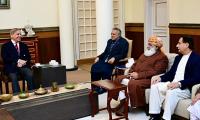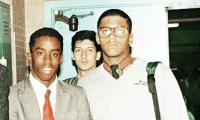Karachi
Al-Asif Square looks even more formidable in the night. The clumsy blocks that make up the apartments have a notorious history of making headlines for all the wrong reasons: hideout for terrorists, drug peddlers and even kidnappers.
The highway zooms by – trawlers, inter-city buses and bikes speed against time. We are here for an innocent indulgence – authentic Afghan pulao and lamb boti.
We ask for directions and an elderly Afghan man offers to show us around. We park our car at an odd spot, make a silent prayer for our side mirrors and walk into Al-Asif Square.
I clasp my chador around me and cover my face partially. It is dark inside and the place reeks of people – too many people.
We walk past a toy shop, a mobile phone shop, a few butchers and discover a well-lit, welcoming restaurant. Even on a Monday night it is full of customers, mostly men who are traveling intercity and office colleagues who are here for the famous pulao.
The owner, a middle-aged Afghan man with a bushy beard, smiles at us and shows us the family area.
A little boy who would be our waiter scurries towards us, “Pardah or no pardah?” he asks, hanging onto a thick, red velvet curtain which he would draw around us if we wished to sit in the covered area.
We opt to sit in the open air. There are no tables or chairs. Instead, cement blocks, a level above the ground, are where food is served to customers. By now, I am comfortable enough to uncover my face. We order Aghan pulao and lamb tikkas with extra fat – an Afghan delicacy. I wait for the food while absorbed by the surroundings. The place is simple, yet clean. The men sit outside in the open sky.
The family area has a roof on top, dotted by a few ceiling fans. Empty soft drink crates lie neatly stacked in a corner. We are sitting on red carpets with plastic mats placed in the middle where the food will be served.
Built in the early 1980s, Al-Asif Square, a large apartment complex comprising thousands of flats and shops is home mostly to Afghans – many of whom had come to Karachi as refugees during the Soviet War.
Elders in the Afghan community claim that, initially, the Urdu speaking community was settled in the huge apartment complex.
But they moved out amid security fears as more and more Afghans settled in squatter settlements around the highway, and police began to conduct operations in the area to root out drugs and weapons.
By 1989, about the time when I was born, the area was taken over by Afghans including key jihadists such as Gulbuddin Hekmatyar, a Pashtun friend who writes on Karachi once told me.
The Afghan pulao arrives. The rice is cooked to perfection. You can actually count each grain. It is sprinkled with raisins – black, soft and juicy. And covered completely with the rice are lamb chops – marinated so well that the meat breaks off at the touch of a spoon.
The lamb tikka comes in next, served with a piece of naan bread. I pick out the fat and eat the meat. My husband gobbles down the fat. It’s salty and chewy.
We are happy and full. And now need something to wash away the layer of grease we feel in the corners of our mouth. We order Kahva – which comes with bits of brown jaggery served separately.
Our little waiter teaches us how to place it in our mouth while we slowly sip the unsweetened tea.
We ask for the bill – it is well under Rs1,000. We walk back to our car, happy to have explored a forbidden part of the city. Happier still because the side mirrors are intact.
A veiw of Mazaar-e-Quaid in Karachi. — APP/FileChoose Your WayThe Studio Seven Art Gallery is hosting an art...
Ambassador of Kazakhstan to Pakistan Yerzhan Kistafin in a meeting with Chief Executive TDAP Muhammad Zubair...
Sindh Culture and Tourism Syed Zulfiqar Ali Shah cuts a ribbon to inaugurate the Sheikh Ayaz Melo on December 20,...
This representational image shows a paralyzed person sitting in a wheelchair. — Pixbay/FileA distribution ceremony...
Representational image of workers of Majlis-e-Wahdat ul Muslimeen holding a protest on December 20, 2024. — INPThe...
Sindh Local Government Minister Saeed Ghani chairs a meeting on December 10, 2024. — Screengrab via...







